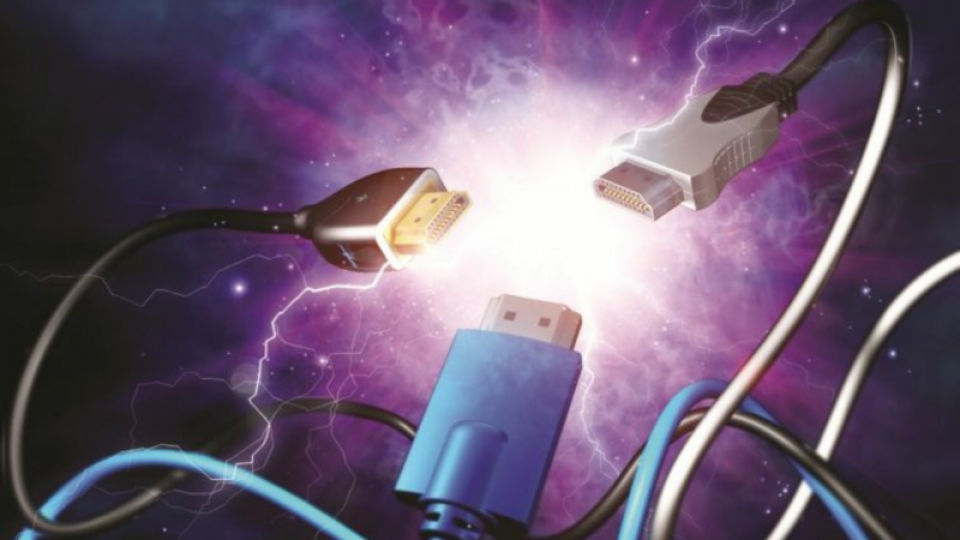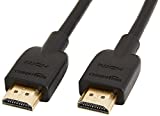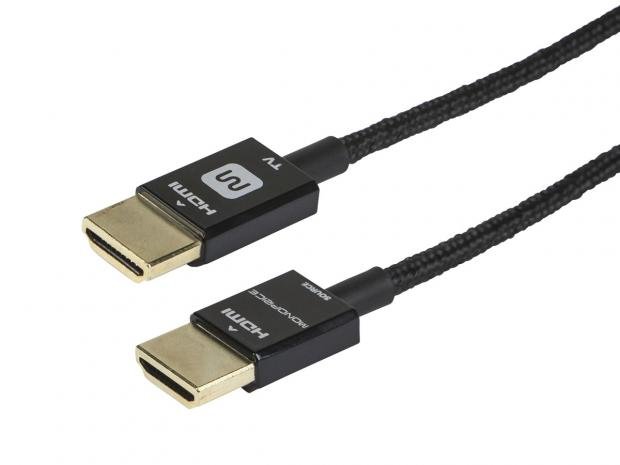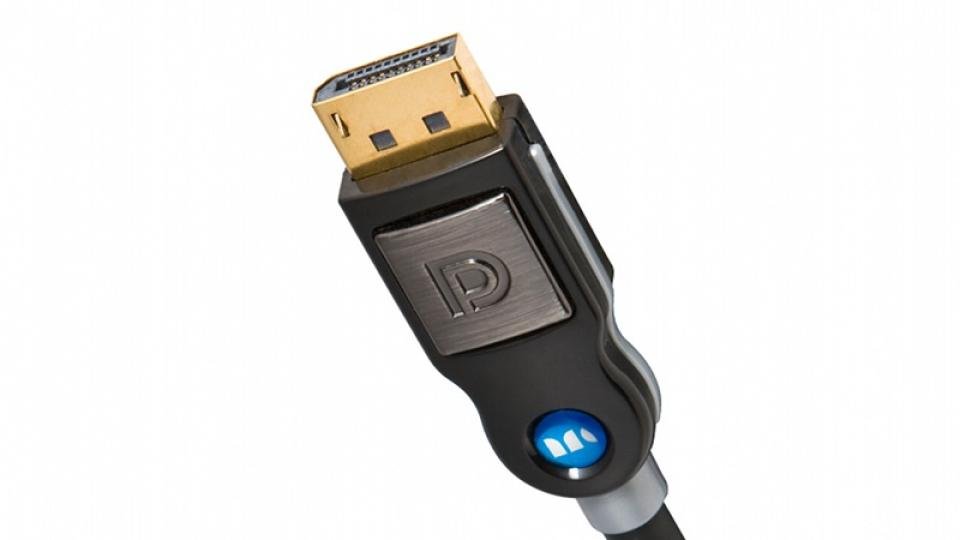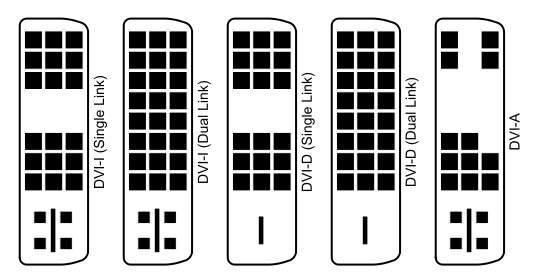We explain the difference between every display connection available and help you decide which is best for you
Most monitors will have a range of different inputs available, and your PC or laptop will also use different outputs, so it can be difficult to decide which is the best connection to use.
Under most circumstances, you can get away with using whichever cable you have lying around – and whatever works – but if you have more specific needs, such as carrying audio, displaying a higher resolution or outputting a higher refresh rate for gaming, you’ll need to be more discerning with your choice of cable.
We outline the different types of connections below and give you different usage scenarios to help you decide. We’ll also outline the best connection and cable to choose for 144Hz and other higher refresh rate displays.
This 2m 4K HDMI cable is now half price
After a decent HDMI cable to carry 4K content? This 2m cable from Amazon should certainly do the trick, and now you can get it for 55% less – down from £20 to just £10.AmazonWas £20Now £10Buy Now
Here’s a quick summary of the connection types:
- HDMI: Audio and video signal, best for TV to PC connections
- DVI: Video only, perfect for older systems or for 144Hz at 1080p
- DisplayPort (DP): The best connector for an audio and video signal, and can transmit 144Hz up to 4K
- VGA: Old, legacy video connector. Only to be used when nothing else available
- USB Type-C: Newest audio, video, data and power connector. The best connection for laptops and mobile devices
HDMI: The best TV to PC connection
HDMI, or “High-Definition Multimedia Interface” to use its full name, is one of the most common video connections. You’ve probably come across it on your television, set-top boxes, tablets, laptops and games consoles.
Amazon Basics High-Speed, Ultra HD HDMI 2.0 Cable, Supports 3D Formats and with Audio Return Channel, 0.9 m
£4.99 Buy now 

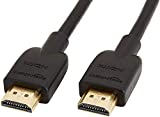
AmazonBasics High-Speed HDMI Cable, 3 Feet, 1-Pack
$7.74 Buy now 


4K HDMI cable 2m,HDMI 2.0 Cable Snowkids flat Ultra hdmi to hdmi high speed 18Gbps 4K@60Hz,UHD 2160p,HD 1080p,3D,ARC,Ethernet,Video return,HDCP 2.2,compatible with fire TV/PS4 quality nylon cord grey
£9.99 Buy now 

HDMI is unique among the many connection options in that it’s able to carry both uncompressed video and uncompressed audio. This is why it’s become the connection of choice for most multimedia devices as it’s a one-cable solution.
Other benefits of HDMI include functions such as HDMI-CEC (HDMI Consumer Electronics Control), which allows you to control numerous devices with one remote. For example, connect a soundbar to your television through an HDMI-CEC compatible port and the soundbar can turn on and off with your television and be controlled by a single remote.

HDMI has seen numerous revisions since its inception in 2002. Its most common version, used in most consumer devices at present, is 1.4 but there’s a newer, more exciting 2.0 specification now becoming more prominent. The main difference between the 1.4 and 2.0 specifications focus around bandwidth available. HDMI 1.4 has a bandwidth maximum of 10.2 Gbps/s whereas the HDMI 2.0 tops out at 18 Gbps/s.
The reason that bandwidth becomes important is due to the advent of 4K content. Due to the limited bandwidth of HDMI 1.4, only 24fps was possible at 4K resolution (3,840 x 2,160). Now, thanks to the extra bandwidth available in the 2.0 spec, up to 60fps at 4K resolution is possible. This also allows you to view 144Hz at 1080p (1,920 x 1,080) through a HDMI 2.0 connection.
Colour depth is also another area where the new HDMI 2 specification gains some advantages. Where 1.4 was limited to 8-bit colour, HDMI 2 has 10-bit or 12-bit available. This is important for when High Dynamic Range (HDR) content becomes more widely available.
HDR can be described as the ratio between the lightest and darkest parts of an image. Typically, with standard dynamic range, you’re losing detail at either end of the light spectrum. Expose a scene for the shadow detail and you end up with blown-out highlights or expose for the highlights and you lose shadow detail. HDR allows a greater range of detail across the full light spectrum.
You’ve probably already come across HDR through photography. Most smartphones now have an HDR mode where they essentially take numerous images at different exposures and combine them. As HDR has become part of the Ultra HD standard, you can expect more Ultra HD Blu-ray content to take advantage. The likes of Amazon and Netflix stream HDR content, tool.
More often than not, if you’re connecting something to a television, HDMI will be your best, and likely only, bet. Most PC monitors will also include an HDMI input. The good news, where it comes to 1.4 versus 2, is that you don’t need to rush out and buy new cables. To take advantage of the 2.0 spec you just need both devices on each end of the cable to be 2-compatible. Any HDMI cable will do, and we’ve already seen that there’s no difference in HDMI cable quality.
The thing to look out for are the different HDMI connection sizes. Not only is there full-sized HDMI (Type A), but you can come across mini-HDMI (Type B) and micro-HDMI (Type C), too. These are commonly found on portable devices such as tablets, camcorders and action cameras, where their physically smaller connections are required. You can either buy HDMI-mini-HDMI/HDMI-Micro-HDMI cables or you can buy mini/micro-HDMI adaptors so you can use your full-size HDMI cables.
Not pertaining to the HDMI cable itself but, instead, the HDMI connection on your device or TV is something called HDCP or “High-Bandwidth Digital Content Protection” to use its full name. The latest version of HDCP is HDCP 2.2, which is necessary for 4K content. HDCP essentially stops you from being able to connect a playback device, such as a Blu-ray player, to a recording device to make copies. This sort of copy protection has been around for decades.
You will likely find that your new Ultra HD/4K TV supports HDCP 2.2 on its HDMI port, but it’s not always for all of them. Some models will only support HDCP 2.2 for HDMI 1 and HDMI 2 inputs, so if you’re connecting a shiny new Ultra HD Blu-ray player, such as the Panasonic DMP-UB900 or Samsung UBD-K8500, make sure to use the correct HDMI input.
DisplayPort: 4K at 144Hz with audio and video capabilities
Until HDMI 2.0 became a standard, DisplayPort had it beat when it came to high resolutions. DisplayPort 1.2 has long been able to carry 3,840 x 2,160-resolution video at 60fps (or a refresh rate of 60Hz) and is the most common DisplayPort specification on most consumer monitors and devices now. This has 17.28Gbits/sec of bandwidth.
A newer 1.3 and 1.4 version, that both have a maximum data rate of 25.92 Gbits/sec, are both becoming more widely available. With the increased bandwidth capabilities, it opens up the floodgates to higher resolutions such as 7,680 x 4,320 (8K).
DisplayPort 1-1.1a is able to output 144Hz at 1080p, while 1.2-1.2a can output 1440p at 144Hz, 1.3 outputs up to 120Hz at 4K, and 1.4 can output 144Hz at 4K using Display Stream Compression (DSC).
The main advantage of DisplayPort is the ability to output to multiple displays through Multi-Stream Transport (MST). You can do this by daisy-chaining compatible monitors over DisplayPort or by connecting a DisplayPort MST splitter to your single DisplayPort output on your PC or laptop. You have to work within the bandwidth limitations of whichever DisplayPort specification you’re using, such as two 1,920 x 1,080 monitors over 1.2 or two 3,840 x 2,160 displays over the DisplayPort 1.3+ specification. As such, DisplayPort is often a great choice for those looking to use multiple monitors.

DP to DP Cable, TechRise 2-Metre Gold Plated DisplayPort to DisplayPort (DP V1.2) Audio and Video Cable 4K 60Hz Resolution Supported – Male to Male
£7.99 Buy now 


Cable Matters DisplayPort to DisplayPort Cable (DP to DP Cable) 6 Feet – 4K Resolution Ready
$8.99 Buy now 

DisplayPort also has advantages where it comes to screen-refresh rates through AMD Adaptive-Sync/FreeSync and Nvidia G-Sync. This is what both companies have opted to use for their graphics implementation. Essentially this helps reduce screen tearing, which is of particular interest for gamers. At the time of updating this article, it’s also the only way you can run Nvidia G-sync on an AMD FreeSync monitor. Read more about it, here.
DVI: 144hz at 1080p
DVI stands for “Digital Visual Interface”, and is another common connection found on PC monitors. Things can become a little confusing when you consider there are three different types of DVI. There’s DVI-A (analog signal), DVI-D (digital signal) and DVI-I (integrated analog and digital signal). Not only that, but DVI-D and DVI-I have single-link and dual-link versions. Nowadays, DVI-A is very uncommon, as it’s no better than VGA.
The differences between single-link and dual-link refer to how much bandwidth the cable can carry. A single-link DVI-D or DVI-I cable can carry 3.96 Gbit/s, which tops out at 1,920 x 1,200 resolution. Dual-link, on the other hand, physically has extra pins on the connectors, allowing a maximum bandwidth of 7.92 Gbit/s and 2,560 x 1,600 resolution. Although DVI is still a common connection, it’s becoming dated, so if you want to output a very high resolution you’ll need to use HDMI or DisplayPort instead.
On the plus side, DVI-D can output a 144Hz refresh rate at 1080p.

Amazon Basics DVI to DVI Cable (4.6 m / 15 Feet)
£11.75 Buy now 


Amazon Basics DVI to DVI Cable – 9.8 Feet (3 Meters)
VGA (D-SUB): A legacy cable connection
VGA is the oldest of the connections outlined in this article. It’s been around for decades, dating back to the days of thick, heavy CRT monitors of yesteryear. VGA stands for Video Graphics Array but can also be referred to as an “RGB connection” or “D-sub”. While VGA can technically output to 1,920 x 1,080, the problem is that it’s an analog connection, so as you push the resolution higher you get image degradation as the signal is converted from analog to digital. Unless you absolutely have to, use one of the other connections instead of VGA.

Rankie VGA to VGA Cable, 1.8 m
£6.99 Buy now 

USB-C: The best laptop connection
With the release of the 2016 MacBook, Apple pushed the boat out and replaced all of its laptop’s connections with the USB Type-C connector. USB Type-C has been making a greater appearance within monitors, such as the Philips Brilliance 258B6QUEB that we reviewed, that has a USB Type-C input, making it the perfect companion for the 2016 MacBook.
What really makes the USC Type-C connector popular is its fully reversible plug, cross-platform compatibility (with new smartphones, tablet, laptops and computers), and its ability to not only output video, but also to transmit audio, data and power. This makes it an extremely versatile video cable, and we expect to see a lot more using it in the coming years.
USB C to USB C Fast Charging Cable, [2 Pack 2M/6.6FT] AviBrex 60W 20V/3A USB C PD/QC Fast Charge Cable Nylon Braided for Samsung Galaxy Note 10 Plus, Google Pixel 2/3/3a/4 XL, iPad pro 2018, MacBook
£6.99 Buy now 

USB C to USB C 60W Cable, JSAUX[2-Pack 6.6ft] Type C Charger Cord Compatible with Samsung Galaxy S21/S21+/S20+ Ultra, Note 20/10 Ultra, MacBook Air/Pro, iPad Pro 2020/2018, iPad Air 2020, Pixel-Grey
$8.49 Buy now 

How to combine HDMI, DisplayPort, DVI, USB-C and VGA
Most motherboards and dedicated graphics cards will have multiple outputs. You can use a combination of these to output to multiple monitors. So if you have HDMI and DVI outputs, connect one monitor using HDMI and the other using DVI. As mentioned above, if you’re using DisplayPort and your graphics card or device supports Multi-Stream Transport, you can daisy-chain DisplayPort and USB-C monitors, too.
If you want to combine the graphics outputs of your motherboard and your dedicated graphics card, this can be possible with certain Intel processors. This uses a “hybrid multi-monitor” mode but will be dependent on the chipset and possibly the motherboard used. You might also need to upgrade the BIOS to get it working. Intel lists the following chipsets as compatible in this hybrid mode: Hybrid multi-monitor support is officially supported with Intel Embedded Graphics Drivers for systems using the Intel Q45/G41/G45 and GM45/GL40/GS45 chipsets, or later.
How to get 144Hz: Which cable is needed for 144Hz?
At a glance:
- Choose DisplayPort for 144Hz up to 4K – supports audio and video
- Choose DVI if DisplayPort isn’t available – supports video only
- Choose HDMI 2 if DisplayPort isn’t available or if you require audio over 144Hz (as DVI doesn’t support audio)
For those of us who game, you might be wondering what’s the best cable to use to achieve a 144hz refresh rate. There are various cables you can use, but you should pay close attention to the version of your output port and that of your monitor.
To get 144Hz, you should ideally use DisplayPort as it’s the most capable out of the bunch. Here, DisplayPort 1.0-1.1a is able to output 144Hz at 1080p, while 1.2-1.2a can output 1440p at 144Hz, 1.3 outputs up to 120Hz at 4K, and 1.4 can output 144Hz at 4K using Display Stream Compression (DSC). It’s the best connection to display 144Hz.
However, some older graphics cards and older monitors don’t have a DisplayPort output or input, but instead, have DVI and HDMI. Thankfully, these support 144Hz, but you’ll need to be wary of the version and the resolution you wish to output.

DP to DP Cable, TechRise 2-Metre Gold Plated DisplayPort to DisplayPort (DP V1.2) Audio and Video Cable 4K 60Hz Resolution Supported – Male to Male
£7.99 Buy now 


Cable Matters DisplayPort to DisplayPort Cable (DP to DP Cable) 6 Feet – 4K Resolution Ready
$8.99 Buy now 

If you want to get 144Hz at 1080p out of an HDMI port, you’ll need to ensure that you’ve got access to an HDMI 2.0 port on both your monitor and graphics card. If your graphics card or monitor are relatively old, chances are, you’re using version 1.4 or below, where you’ll have a maximum refresh rate of 120Hz at 1080p. This is where DVI comes in handy, as it’s able to achieve 144Hz at 1080p.
No matter what connection you choose, you’ll want to ensure that you go into your monitor’s settings (OSD) to set the DP version to 1.2 (or higher) or HDMI 2.0 (or higher), and finally check your GPU settings are configured the faster refresh rate.

